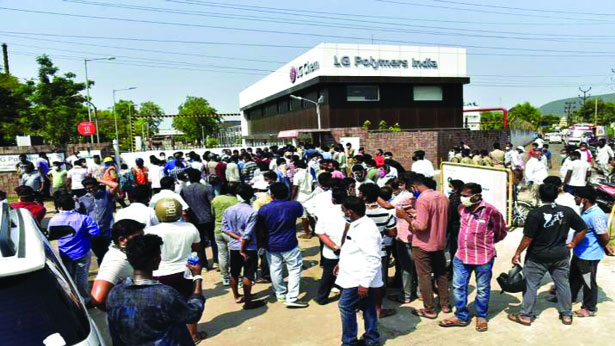The gas leak at a chemical unit near Visakhapatnam shows why we never learn lessons and our laws mean nothing
Just when the nation is struggling to breathe as COVID-19 tightens its grip, the preventive lockdown because of it extracted a heavy price as gas leaked out of a shut chemical plant near Visakhapatnam and choked people in their homes. It seemed the ghosts of the Bhopal gas tragedy of 1984 revisited us as the leak affected over 5,000 people while they lay asleep in the wee hours at Gopalapatnam nvillage. At last count, 11 had died but thousands are gasping for survival in hospitals. Toxic styrene escaped from an LG Polymers facility when its owners tried restarting the plant at midnight following the easing of lockdown restrictions for business and an alarm malfunctioned. Clearly no safety protocol or a cautionary approach was followed in the rush for reopening the unit. The gas came from two 5,000-tonne tanks that had been lying unattended and unmonitored during the 40-day lockdown. In such an uncalibrated scenario, gases do not remain inert, they react, cause a chemical reaction and generate heat that might have triggered the leak. An official from the owner firm himself accepted that there were 1,800 tonnes of styrene in the storage tank and that stagnation and changes in temperature might have resulted in auto polymerisation, which could have caused the sudden vapourisation of the gas. So negligence certainly cannot be ruled out. The Manufacture, Storage and Import of Hazardous Chemical (Amendment) Rules, 2000, list a number of chemicals that call for safe handling, including styrene. Even mild exposure to it results in irritation of mucous membrane and eyes and affects the gastrointestinal system. Long-term exposure impacts the central nervous system and leads to headache, fatigue and weakness. Therefore, a safety audit ought to have been conducted before resuming operations, considering that the plant was old and had considerable wear and tear. In fact, a no-objection certificate from the pollution control board should have been made mandatory before even attempting a re-opening. Though the scale of the leak was lesser than that of Bhopal, this was no less a serious industrial tragedy. It also showed that we still have not learnt lessons from our past. Although the industrial unit was located in the outskirts of the city, 20 villages thrived in a radius of five kilometres. It is too late to ask questions about why zoning separation wasn’t done all these years. At least, given the risks opening an unmaintained facility entailed, authorities ought to have warned or evacuated residents. As a result of this negligence, we witnessed apocalyptic scenes of villagers rushing out of their homes as they were being asphyxiated and literally falling unconscious on the roads. Some were trapped in their houses, some tried jumping into the well and out of their balconies.
This too, like Bhopal, will remain in the news for a while and then be quickly forgotten. For the corporate owners and multinational giants, despite protracted legal battles, always manage to wriggle out of reparations or culpability, usually using their proximity to Governments of the day or negotiating new investment prospects. And chemical unit accidents keep happening with astonishing regularity. According to the National Disaster Management Authority (NDMA), 130 chemical accidents had been reported around the country in the last decade alone, causing 259 deaths and 563 serious injuries. The GAIL pipeline blast of 2014 claimed 15 lives while injuring over 40 others. The same year, at Bhilai steel plant, a gas leak killed six people and injured over 40. And in 2017, more than 470 school children were hospitalised in Delhi’s Tughlaqabad area after they inhaled toxic fumes emanating from a factory nearby. It is because the law never takes its course that industrial safety standards in the country keep getting short-changed or flouted. The Environment Protection Act (EPA) came up in 1986 in the aftermath of Bhopal. The following year, soon after the oleum gas leak in New Delhi, a new chapter was added to the Factories Act, 1948, widening the scope of what constitutes risk. Further, the Public Liability Insurance Act (PLIA), too, came into effect to provide interim compensation to the victims in the event of an industrial disaster. Forty years on, pertinent questions arise today: Are these laws still relevant? Have they been used appropriately? Is there any need for more stringent laws? In the absence of an active regulatory regime, all the laws to tackle chemical disasters will mean nothing.
(Courtesy: The Pioneer)








 OpinionExpress.In
OpinionExpress.In















Comments (0)